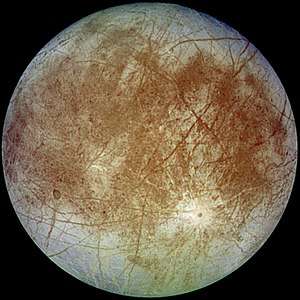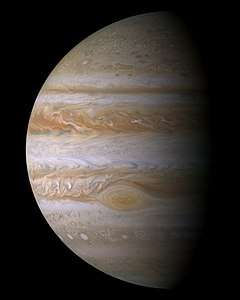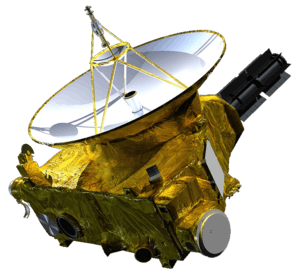Europa Clipper
Europa Clipper[9] (previously known as Europa Multiple Flyby Mission) is an interplanetary mission in development by NASA comprising an orbiter. Set for a launch in 2024,[6] the spacecraft is being developed to study the Galilean moon Europa through a series of flybys while in orbit around Jupiter.
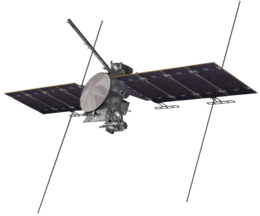 Artist's rendering of the Europa Clipper spacecraft | |||||||||||||||||||||
| Names | Europa Multiple Flyby Mission | ||||||||||||||||||||
|---|---|---|---|---|---|---|---|---|---|---|---|---|---|---|---|---|---|---|---|---|---|
| Mission type | Europa reconnaissance | ||||||||||||||||||||
| Operator | NASA | ||||||||||||||||||||
| Website | europa europa | ||||||||||||||||||||
| Mission duration | Cruise: 6 years[1][2] Science phase: 4 years | ||||||||||||||||||||
| Spacecraft properties | |||||||||||||||||||||
| Manufacturer | Jet Propulsion Laboratory | ||||||||||||||||||||
| Launch mass | 6,000 kg (13,000 lb)[3][4] | ||||||||||||||||||||
| Dry mass | 2,616 kg (5,767 lb) (without science payload)[4] | ||||||||||||||||||||
| Payload mass | 352 kg (776 lb)[4] | ||||||||||||||||||||
| Dimensions | Height: 6 m (20 ft) Solar panel span: 22 m (72 ft)[3] | ||||||||||||||||||||
| Power | 600 W (0.80 hp) from solar cells[5] | ||||||||||||||||||||
| Start of mission | |||||||||||||||||||||
| Launch date | 2024[6] | ||||||||||||||||||||
| Rocket |
| ||||||||||||||||||||
| Launch site | TBD | ||||||||||||||||||||
| Jupiter orbiter | |||||||||||||||||||||
| Orbital insertion | 2030–2031 (alternate rocket) | ||||||||||||||||||||
| Orbits | 44[3][7] | ||||||||||||||||||||
| |||||||||||||||||||||
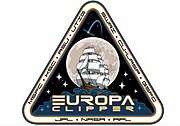 | |||||||||||||||||||||
This mission is a scheduled flight of the Planetary Science Division, designated a Large Strategic Science Mission, and funded under the Planetary Missions Program Office's Solar System Exploration program as its second flight.[10][11] It is also supported by the new Ocean Worlds Exploration Program.[12] Europa Clipper will perform follow-up studies to those made by the Galileo spacecraft during its eight years in Jupiter orbit, which indicated the existence of a subsurface ocean underneath Europa's ice crust. Plans to send a spacecraft to Europa were initially conceived with projects such as Europa Orbiter and Jupiter Icy Moons Orbiter, in which a spacecraft would be injected into orbit around Europa. However, due to the adverse effects of radiation from Jupiter's magnetosphere in Europan orbit, it was decided that it would be safer to inject a spacecraft into an elliptical orbit around Jupiter and make 44 close flybys of the moon instead. The mission began as a joint investigation between the Jet Propulsion Laboratory and the Applied Physics Laboratory.
The mission will complement ESA's Jupiter Icy Moons Explorer launching in 2022, which will fly-by Europa twice and Callisto multiple times before moving into orbit around Ganymede. They may launch within a year of each other, but the Jupiter Icy Moons Explorer may have a cruise phase almost three times as long. This would be the case if Europa Clipper launches on the Space Launch System and uses a direct trajectory to Jupiter. If another launch vehicle and Earth or other gravity assists are used, the two missions would arrive at more similar times.
The Europa Clipper orbiter will be built and manufactured with a scientific payload of nine instruments, contributed by the JPL, APL, Southwest Research Institute, University of Texas at Austin, Arizona State University and University of Colorado Boulder.
History

Europa has been identified as one of the locations in the Solar System that could possibly harbor microbial extraterrestrial life.[13][14][15] Immediately following the Galileo spacecraft's discoveries, JPL conducted preliminary mission studies that envisioned a capable spacecraft such as the Jupiter Icy Moons Orbiter (a US$16bn mission concept),[16] the Jupiter Europa Orbiter (a $4.3bn concept), an orbiter ($2bn concept), and a multi-flyby spacecraft: Europa Clipper.[17]
Europa Clipper is still in its planning phase and early development, but the approximate cost estimate rose from $2 billion in 2013,[13][15] to $4.25 billion in 2020.[18][19] The mission is a joint project between the Johns Hopkins University's Applied Physics Laboratory (APL), and the Jet Propulsion Laboratory (JPL).[1][20] The mission's name is a reference to the lightweight clipper ships of the 19th century that routinely plied trade routes around the world.[21] The moniker was chosen because the spacecraft will "sail" past Europa, as frequently as every two weeks.[21]
In March 2013, $75 million were authorized to expand on the formulation of mission activities, mature the proposed science goals, and fund preliminary instrument development,[22] as suggested in 2011 by the Planetary Science Decadal Survey.[1][15] In May 2014, a House bill substantially increased the Europa Clipper (referred to as Europa Multiple Flyby Mission) funding budget for the 2014 fiscal year from $15 million[23][24] to $100 million to be applied to pre-formulation work.[25][26]
Following the 2014 election cycle, bipartisan support was pledged to continue funding for the Europa Multiple Flyby Mission project.[27][28] The executive branch has also granted $30 million for preliminary studies.[29][30]
In April 2015, NASA offered to the European Space Agency to submit concepts for an additional probe to fly together with the Europa Clipper spacecraft, with a mass limit of 250 kg maximum.[31] It could be a simple probe, an impactor,[32] or a lander.[33] An internal assessment at ESA is underway to see if there is interest and funds available,[34][35][36][37] opening a collaboration scheme similar to the very successful Cassini-Huygens approach.[37]
In May 2015, NASA chose nine instruments that would fly on board the orbiter. They will cost about $110 million over the next three years.[38] In June 2015, NASA announced its approval of the mission concept, allowing the orbiter to move to its formulation stage,[39] and in January 2016 it approved a lander as well.[40][41] In May 2016, the Ocean Worlds Exploration Program was approved,[42] of which the Europa mission is part.[12] In February 2017, the mission moved from Phase A to Phase B.[43]
Phase B was the preliminary design phase of the mission, which continued into 2019.[43] In addition, subsystem vendors were selected, as well as prototype hardware elements for the science instruments. Spacecraft sub-assemblies will be built and tested as well.[43] On 19 August 2019, the Europa Clipper was confirmed to move on to Phase C: final design and fabrication.[44] Phase D will include assembly, testing, and launch.
On 18 July 2017, the House Space Subcommittee held hearings on the Europa Clipper as a scheduled Large Strategic Science Missions class, and to discuss a possible follow up mission simply known as the Europa Lander.[10]
Objectives
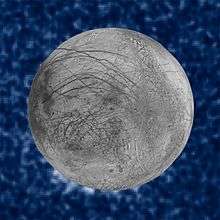
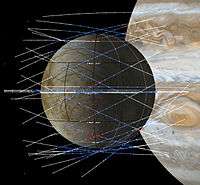
The goals of Europa Clipper are to explore Europa, investigate its habitability and aid in the selection of a landing site for the future Europa Lander.[41][45] This exploration is focused on understanding the three main requirements for life: liquid water, chemistry, and energy.[46] Specifically, the objectives are to study:[20]
- Ice shell and ocean: Confirm the existence, and characterize the nature, of water within or beneath the ice, and processes of surface-ice-ocean exchange
- Composition: Distribution and chemistry of key compounds and the links to ocean composition
- Geology: Characteristics and formation of surface features, including sites of recent or current activity
Strategy

Because Europa lies well within the harsh radiation fields surrounding Jupiter, even a radiation-hardened spacecraft in near orbit would be functional for just a few months.[17] Most instruments can gather data far faster than the communications system can transmit it to Earth because there are a limited number of antennas available on Earth to receive the scientific data.[17] Therefore, another key limiting factor on science for a Europa orbiter is the time available to return data to Earth. In contrast, the amount of time during which the instruments can make close-up observations is less important.[17]
Studies by scientists from the Jet Propulsion Laboratory show that by performing several flybys with many months to return data, the Europa Clipper concept will enable a $2bn mission to conduct the most crucial measurements of the cancelled $4.3bn Jupiter Europa Orbiter concept.[17] Between each of the flybys, the spacecraft will have seven to ten days to transmit data stored during each brief encounter. That will let the spacecraft have up to a year of time to transmit its data compared to just 30 days for an orbiter. The result will be almost three times as much data returned to Earth, while reducing exposure to radiation.[17] The Europa Clipper will not orbit Europa, but instead orbit Jupiter and conduct 44 flybys of Europa at altitudes from 25 to 2,700 km (16 to 1,700 mi) each during its 3.5-year mission.[3][2][47] A key feature of the mission concept is that the Clipper would use gravity assists from Europa, Ganymede and Callisto to change its trajectory, allowing the spacecraft to return to a different close approach point with each flyby.[48] Each flyby would cover a different sector of Europa in order to achieve a medium-quality global topographic survey, including ice thickness.[49] The Europa Clipper could conceivably flyby at low altitude through the plumes of water vapor erupting from the moon's ice crust, thus sampling its subsurface ocean without having to land on the surface and drill through the ice.[23][24]
The Europa Clipper will inherit tested technology of the Galileo and Juno Jupiter orbiters with regards to radiation protection. Shielding will be provided by 150 kilograms of titanium. To maximize its effectiveness, the electronics will be nested in the core of the spacecraft for additional radiation protection.[49]
Design and construction
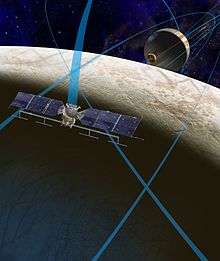
Power
Both radioisotope thermoelectric generator and photovoltaic power sources were assessed to power the orbiter.[50] Although solar power is only 4% as intense at Jupiter as it is in Earth's orbit, powering a Jupiter orbital spacecraft by solar panels was demonstrated by the Juno mission. The alternative to solar panels was a multi-mission radioisotope thermoelectric generator (MMRTG), fueled with plutonium-238.[2][49] The power source has already been demonstrated in the Mars Science Laboratory (MSL) mission. Five units were available, with one reserved for the Mars 2020 rover mission and another as backup. In September 2013, it was decided that the solar array was the less expensive option to power the spacecraft, and on 3 October 2014, it was announced that solar panels were chosen to power Europa Clipper. The mission's designers determined that solar was both cheaper than plutonium and practical to use on the spacecraft.[50] Despite the increased weight of solar panels compared to plutonium-powered generators, the vehicle's mass had been projected to still be within acceptable launch limits.[51]
Initial analysis suggest that each panel will have a surface area of 18 m2 (190 sq ft) and produce 150 watts continuously when pointed towards the Sun while orbiting Jupiter.[52] While in Europa's shadow, batteries will enable the spacecraft to continue gathering data. However, ionizing radiation can damage solar panels. The Europa Clipper's orbit will pass through Jupiter's intense magnetosphere, which is expected to gradually degrade the solar panels as the mission progresses.[49] The solar panels will be provided by Airbus Defense and Space Netherlands.[53]
Scientific payload
The Europa Clipper mission is equipped with a sophisticated suite of 9 instruments to study Europa's interior and ocean, geology, chemistry, and habitability. The electronic components will be protected from the intense radiation by a 150-kilogram titanium and aluminum shield.[3][49] The spacecraft payload and trajectory are subject to change as the mission design matures.[54] The nine science instruments for the orbiter, announced in May 2015, have an estimated total mass of 82 kg (181 lb) and are listed below:[55]
| Instrument name | Abbr. | Description and scientific objectives |
|---|---|---|
| Europa Thermal Emission Imaging System | E-THEMIS | The Europa Thermal Emission Imaging System will provide high spatial resolution, multi-spectral imaging of Europa in the mid infrared and far infrared bands to help detect active sites, such as potential vents erupting plumes of water into space. This instrument is derived from the Thermal Emission Imaging System (THEMIS) on the 2001 Mars Odyssey orbiter, also developed by Philip Christensen.
|
| Mapping Imaging Spectrometer for Europa | MISE | The Mapping Imaging Spectrometer for Europa is an imaging near infrared spectrometer to probe the surface composition of Europa, identifying and mapping the distributions of organics (including amino acids and tholins[56][57]), salts, acid hydrates, water ice phases, and other materials. From these measurements, scientists expect to be able to relate the moon's surface composition to the habitability of its ocean.[57][58] MISE is built in collaboration with the Johns Hopkins University Applied Physics Laboratory (APL).
|
| Europa Imaging System | EIS | The Europa Imaging System is a visible-spectrum wide and narrow angle camera instrument that will map most of Europa at 50 m (160 ft) resolution, and will provide images of selected surface areas at up to 0.5 m resolution.
|
| Europa Ultraviolet Spectrograph | Europa - UVS | The Europa Ultraviolet Spectrograph instrument will be able to detect small plumes and will provide valuable data about the composition and dynamics of the moon's exosphere. Principal Investigator Kurt Retherford was part of a group that discovered plumes erupting from Europa while using the Hubble Space Telescope in the UV spectrum.[59]
|
| Radar for Europa Assessment and Sounding: Ocean to Near-surface | REASON | The Radar for Europa Assessment and Sounding: Ocean to Near-surface (REASON)[60][61] is a dual-frequency ice penetrating radar instrument that is designed to characterize and sound Europa's ice crust from the near-surface to the ocean, revealing the hidden structure of Europa's ice shell and potential water pockets within. This instrument will be built by JPL.[57][60]
|
| Interior Characterization of Europa using Magnetometry | ICEMAG | ICEMAG was cancelled due to cost overruns.[62] Will be replaced by a simpler magnetometer.[63] |
| Plasma Instrument for Magnetic Sounding | PIMS | The Plasma Instrument for Magnetic Sounding measures the plasma surrounding Europa to characterise the magnetic fields generated by plasma currents. These plasma currents mask the magnetic induction response of Europa's subsurface ocean. In conjunction with a magnetometer, it is key to determining Europa's ice shell thickness, ocean depth, and salinity. PIMS will also probe the mechanisms responsible for weathering and releasing material from Europa's surface into the atmosphere and ionosphere and understanding how Europa influences its local space environment and Jupiter's magnetosphere.[64][65]
|
| Mass Spectrometer for Planetary Exploration | MASPEX | The Mass Spectrometer for Planetary Exploration will determine the composition of the surface and subsurface ocean by measuring Europa's extremely tenuous atmosphere and any surface materials ejected into space. Jack Waite, who led development of MASPEX, was also Science Team Lead of the Ion and Neutral Mass Spectrometer (INMS) on Cassini spacecraft.
|
| SUrface Dust Analyzer | SUDA | The SUrface Dust Analyzer[8] is a mass spectrometer that will measure the composition of small solid particles ejected from Europa, providing the opportunity to directly sample the surface and potential plumes on low-altitude flybys. The instrument is capable of identifying traces of organic and inorganic compounds in the ice of ejecta.[66]
|
Possible secondary elements
The Europa Clipper mission considers an extra mass of about 250 kg to carry an additional flight element.[31] About a dozen proposals have been suggested, a few of which are described next:
- Nanosatellites
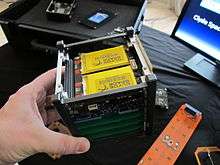
Since the Europa Clipper mission may not be able to easily modify its orbital trajectory or altitude to fly through the episodic water plumes, scientists and engineers working on the mission have investigated deploying from the spacecraft several miniaturized satellites of the CubeSat format, possibly driven by ion thrusters, to fly through the plumes and assess the habitability of Europa's internal ocean.[2][30][67] Some early proposals include Mini-MAGGIE,[68] DARCSIDE,[69][70] and Sylph.[71] The Europa Clipper would relay signals from the nanosatellites back to Earth. With propulsion, some nanosatellites could also be capable of entering orbit around Europa.[49]
- Secondary orbiters
- Biosignature Explorer for Europa
- NASA is also assessing the release of an additional 250 kg (550 lb) probe called Biosignature Explorer for Europa (BEE), that would be equipped with a basic bi-propellant engine and cold gas thrusters to be more agile and responsive to the episodic activity on Europa and sample and analyze the water plumes for biosignatures and life evidence before they are destroyed by radiation.[54] The BEE plume probe would be equipped with a proven mass spectrometer combined with gas chromatograph separation. It would also carry a UV plume targeting camera as well as visible and IR cameras to image the active region with better resolution than the Clipper mother ship instruments.[54] The BEE probe would fly through at 2–10 km altitude, then make a quick exit and perform its analysis far from the radiation belts.
- Europa Tomography Probe (ETP)
- A European proposal is an independent powered spacecraft equipped with a magnetometer that would orbit Europa on a polar orbit for at least six months. It would determine the deep interior structure of Europa and provide a good determination of the ice shell thickness and ocean depth, which arguably cannot be done accurately by multiple flybys.[31]
- Impactor probes
- Some proposed impactor probe concepts include those by the Netherlands,[72] and United Kingdom.[73]
- Flyby sample return
The Europa Life Signature Assayer (ELSA) concept by the University of Colorado consists of a probe that is flown as a secondary payload. ELSA would use a small impactor to create a plume of subsurface particles and catapult them to altitudes where it would be able to pass through to collect samples and analyze them on board.[74][75] A variation of this concept is the 1996 Ice Clipper, which involves a 10 kg impactor that would be jettisoned from the main spacecraft to impact Europa, thereby creating a debris cloud in nearby space about 100 km altitude, subsequently sampled by a small spacecraft on a close flyby and use Europa's gravitational force for a free return trajectory.[76][77][78] The collection mechanism is tentatively considered to be Aerogel (similar to Stardust mission).
Add-on lander history
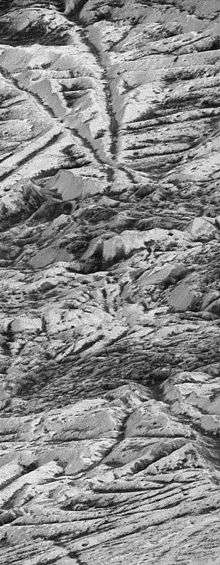
An early Europa Clipper concept called for including a stationary lander about 1 meter in diameter, perhaps about 230 kg (510 lb) with a maximum of 30 kg (66 lb) for instruments[41] plus propellant. Suggested instruments were a mass spectrometer and a Raman spectrometer to determine the chemistry of the surface.[41] The lander was proposed to be delivered to Europa by the main spacecraft and possibly require the sky crane system for a high precision, soft landing near an active crevasse.[79] The lander would operate about 10 days on the surface using battery power.[41] In January 2016, it was determined that including the additional mass of a lander and detachable probes, meant the Europa Clipper may need be launched with NASA's Space Launch System (SLS) heavy lift launch vehicle[40][41] that could arrive at Jupiter on a direct trajectory in less than three years.[2]
The Europa Clipper would take about three years to image 95% of the surface of Europa at about 50 meters per pixel. With this data, scientists could then find a suitable landing site.[79] By one estimate, including a lander could add as much as $1 billion to the mission's cost.[79]
- Separate launch
.jpg)
It was determined in February 2017 that designing a system capable of landing on a surface about which very little is known, is too much risk, and that the Europa Clipper will lay the foundation for a future landing mission by performing detailed reconnaissance first.[80] This led to a stand-alone mission proposal in 2017: the Europa Lander.[81] The NASA Europa Lander, if funded, would be launched separately in 2025[82] to complement the studies by the Europa Clipper mission.[83][84] If funded, approximately 10 proposals may be selected to proceed into a competitive process with a $1.5 million budget per investigation.[85] The President's 2018 and 2019 federal budget proposals do not fund the Europa Lander, but it did assign $195 million[86] for concept studies.[87][88]
Launch and trajectory
In the baseline mission profile, Europa Clipper is planned to be carried aboard NASA's Space Launch System (SLS) heavy-lift launch vehicle,[40][41] on a direct trajectory to Jupiter in less than three years.[2] As of August 2019, launch is scheduled for 2024.[6] Since the development and readiness of the SLS may not match the mission's timing, an alternative trajectory profile would use a commercial rocket such as Delta IV Heavy or Falcon Heavy, with a longer 6-year cruise time involving gravity assist maneuvers at Venus, Earth and Earth again.[89] Another option is to launch on a Falcon Heavy and use a Star 48 solid rocket as a kick stage. This would require only one gravity assist, with Earth, and would shorten the cruise phase.[90] Launch windows are available from 2022 to 2025.[4]
 Animation of Europa Clipper trajectory:
Animation of Europa Clipper trajectory:
Earth · Jupiter · Europa Clipper Animation of Europa Clipper trajectory around Jupiter
Animation of Europa Clipper trajectory around Jupiter
See also
- Europa Orbiter – A canceled orbiter mission to Europa by NASA
- Europa Jupiter System Mission – Laplace – A canceled orbiter mission concept to Jupiter
- Exploration of Jupiter
- Galileo (spacecraft) – Unmanned NASA spacecraft which studied the planet Jupiter and its moons
- Jupiter Icy Moons Explorer – European orbiter sent to Europa, Ganymede, and Callisto; large-class mission in the ESA Science Programme
- Jupiter Icy Moons Orbiter – A canceled NASA orbiter mission to Jupiter's icy moons
- Laplace-P – Proposed Russian spacecraft to study the Jovian moon system and land on Ganymede
References
- Leone, Dan (July 22, 2013). "NASA's Europa Mission Concept Progresses on the Back Burner". Space News.
- Phillips, Cynthia B.; Pappalardo, Robert T. (May 20, 2014). "Europa Clipper Mission Concept". Eos, Transactions American Geophysical Union. 95 (20): 165–167. Bibcode:2014EOSTr..95..165P. doi:10.1002/2014EO200002.
- Europa Clipper Mission. Europa Clipper home page at NASA. Accessed on 2 October 2019.
- Goldstein, Barry; Kastner, Jason (March 2018). "Weigh Your Options Carefully" (PDF). The Sextant – Europa Clipper Newsletter. Vol. 2 no. 1. Jet Propulsion Laboratory. p. 3. Retrieved September 20, 2018.
- Goldstein, Barry; Pappalardo, Robert (February 19, 2015). "Europa Clipper Update" (PDF). Outer Planets Assessment Group.
- Europa Clipper passes key review Jeff Foust, Space News, 22 August 2019.
- "All Systems Go for NASA's Mission to Jupiter Moon Europa" (Press release). NASA. June 17, 2015. Retrieved May 29, 2019.
- https://europa.nasa.gov/mission/science-instruments/
- "Europa Multiple Flyby Mission". Solar System Exploration. National Aeronautics and Space Administration. Archived from the original on July 10, 2015. Retrieved July 9, 2015.
- Wolfe, Alexis; McDonald, Lisa (July 21, 2017). "Balance of NASA Planetary Science Missions Explored at Hearing". American Institute of Physics. Retrieved May 29, 2019.
- PMPO staff. "Solar System Exploration Missions List". Planetary Missions Program Office (PMPO). National Aeronautics and Space Administration (NASA). Archived from the original on March 27, 2018. Retrieved March 27, 2018.
- "NASA'S FY2016 BUDGET REQUEST – Overview" (PDF). SpacePolicyOnline.com. May 27, 2015. Retrieved May 29, 2019.
- Dreier, Casey (December 12, 2013). "Europa: No Longer a "Should," But a "Must"". The Planetary Society.
- Schulze-Makuch, Dirk; Irwin, Louis N. (2001). "Alternative Energy Sources Could Support Life on Europa" (PDF). Departments of Geological and Biological Sciences. University of Texas at El Paso. Archived from the original (PDF) on July 3, 2006.
- Zabarenko, Deborah (March 7, 2011). "Lean U.S. missions to Mars, Jupiter moon recommended". Reuters.
- "Project Prometheus final report – page 178" (PDF). 2005. Archived from the original (PDF) on March 4, 2016. Retrieved January 20, 2015.
- Kane, Van (August 26, 2014). "Europa: How Less Can Be More". Planetary Society. Retrieved August 29, 2014.
- Clipper passes key review, Jeff Foust, Space News, 22 August 2019.
- NASA Europa Mission Could Potentially Spot Signs of Alien Life, Mike Wall, Space.com, 26 October 2019.
- Pappalardo, Robert; Cooke, Brian; Goldstein, Barry; Prockter, Louise; Senske, Dave; Magner, Tom (July 2013). "The Europa Clipper" (PDF). OPAG Update. Lunar and Planetary Institute.
- Dyches, Preston (March 9, 2017). "NASA Mission Named 'Europa Clipper'". JPL – NASA. Retrieved October 28, 2017.
- "Destination: Europa". Europa SETI. March 29, 2013. Archived from the original on August 23, 2014.
- Wall, Mike (March 5, 2014). "NASA Eyes Ambitious Mission to Jupiter's Icy Moon Europa by 2025". Space.com. Retrieved April 15, 2014.
- Clark, Stephen (March 14, 2014). "Economics, water plumes to drive Europa mission study". Spaceflight Now. Retrieved April 15, 2014.
- Zezima, Katie (May 8, 2014). "House gives NASA more money to explore planets". Washington Post. Retrieved May 9, 2014.
- Morin, Monte (May 8, 2014). "$17.9-billion funding plan for NASA would boost planetary science". Los Angeles Times.
- Nola Taylor Redd (November 5, 2014). "To Europa! Mission to Jupiter's Moon Gains Support in Congress". Space.com.
- Dreier, Casey (February 3, 2015). "It's Official: We're On the Way to Europa". The Planetary Society.
- Kane, Van (February 3, 2015). "2016 Budget: Great Policy Document and A Much Better Budget". Future Planetary Exploration.
- Clark, Stephen (March 10, 2015). "Europa Multiple Flyby Mission concept team aims for launch in 2022". Space Flight Now.
- Mauro Di Benedetto, Luigi Imperia, Daniele Durantea, Michele Dougherty, Luciano Iessa, Virginia (September 26–30, 2016). Augmenting NASA Europa Clipper by a small probe: Europa Tomography Probe (ETP) mission concept (PDF). 67th International Astronautical Congress (IAC).CS1 maint: multiple names: authors list (link)
- Akon – A Penetrator for Europa. (PDF) Geraint Jones. Geophysical Research Abstracts. Vol. 18, EGU2016-16887, 2016. EGU General Assembly 2016.
- Clark, Stephen (April 10, 2015). "NASA invites ESA to build Europa piggyback probe". Space Flight Now. Retrieved April 17, 2015.
- Amos, Jonathan (April 19, 2016). "European scientists set eyes on ice moon Europa". BBC News. Retrieved April 19, 2016.
- Blanc, Michel; Jones, Geraint H.; Prieto-Ballesteros, Olga; Sterken, Veerle J. (2016). "The Europa initiative for ESA's cosmic vision: a potential European contribution to NASA's Europa mission" (PDF). Geophysical Research Abstracts. 18: EPSC2016-16378. Bibcode:2016EGUGA..1816378B. Retrieved September 29, 2016.
- "Joint Europa Mission: ESA and NASA together towards Jupiter icy moon". Research Italy. May 16, 2017. Retrieved May 29, 2019.
- Joint Europa Mission (JEM): A multi-scale study of Europa to characterize its habitability and search for life. (PDF) Michel Blanc, Olga Prieto Ballesteros, Nicolas Andre, and John F. Cooper. Geophysical Research Abstracts. Vol. 19, EGU2017-12931, 2017. EGU General Assembly 2017.
- Klotz, Irene (May 26, 2015). "NASA's Europa Mission Will Look for Life's Ingredients". Discovery News.
- Howell, Elizabeth (June 20, 2015). "NASA's Europa Mission Approved for Next Development Stage". Space.com.
- Kornfeld, Laurel (January 4, 2016). "Additional $1.3 billion for NASA to fund next Mars rover, Europa mission". The Space Reported. Archived from the original on January 18, 2016.
- Kane, Van (January 5, 2016). "A Lander for NASA's Europa Mission". The Planetary Society.
- "NASA'S FY2017 BUDGET REQUEST – Status at the End of the 114th Congress" (PDF). SpacePolicyOnline.com. December 28, 2016.
- Greicius, Tony (February 21, 2017). "NASA's Europa Flyby Mission Moves into Design Phase". NASA.
- McCartney, Gretchen; Johnson, Alana (August 19, 2019). "Mission to Jupiter's Icy Moon Confirmed". NASA.
- Pappalardo, Robert T.; Vance, S.; Bagenal, F.; Bills, B.G.; Blaney, D.L.; Blankenship, D.D.; Brinckerhoff, W.B.; Connerney, J.E.P.; Hand, K.P.; Hoehler, T.M.; Leisner, J.S.; Kurth, W.S.; McGrath, M.A.; Mellon, M.T.; Moore, J.M.; Patterson, G.W.; Prockter, L.M.; Senske, D.A.; Schmidt, B.E.; Shock, E.L.; Smith, D.E.; Soderlund, K.M. (2013). "Science Potentialfrom a Europa Lander" (PDF). Astrobiology. 13 (8): 740–73. Bibcode:2013AsBio..13..740P. doi:10.1089/ast.2013.1003. hdl:1721.1/81431. PMID 23924246.
- Bayer, Todd; Buffington, Brent; Castet, Jean-Francois; Jackson, Maddalena; Lee, Gene; Lewis, Kari; Kastner, Jason; Schimmels, Kathy; Kirby, Karen (March 4, 2017). Europa mission update: Beyond payload selection. 2017 IEEE Aerospace Conference. Big Sky, MT. doi:10.1109/AERO.2017.7943832. ISBN 978-1-5090-1613-6.
- "Europa Clipper". NASA - JPL. Retrieved January 2, 2019.
- Europa Clipper Mission Concept: Exploring Jupiter's Ocean Moon (PDF). Cynthis B. Phillips, and Robert T. Pappalardo. Eos, Transactions American Geophysical Union, Volume 95, Issue 20. May 20, 2014.
- Kane, Van (May 26, 2013). "Europa Clipper Update". Future Planetary Exploration.
- A. Eremenko et al., "Europa Clipper spacecraft configuration evolution," 2014 IEEE Aerospace Conference, pp. 1–13, Big Sky, MT, March 1–8, 2014
- Foust, Jeff (October 8, 2014). "Europa Clipper Opts for Solar Power over Nuclear". Retrieved February 8, 2015.
- Dreier, Casey (September 5, 2013). "NASA's Europa Mission Concept Rejects ASRGs – May Use Solar Panels at Jupiter Instead". The Planetary Society.
- "Spacecraft Highlights" (PDF). The Sextant – Europa Clipper Newsletter. Vol. 2 no. 1. Jet Propulsion Laboratory. March 2018. p. 3. Retrieved September 20, 2018.
- Amato, Michael J.; Spidaliere, P.; Mahaffy, P. (2016). Biosignature Explorer for Europa (BEE) Probe – The Concept for Directly Searching for Life Evidence on Europa at Lower Cost and Risk (PDF). 47th Lunar and Planetary Science Conference.
- "NASA's Europa Mission Begins with Selection of Science Instruments". Jet Propulsion Laboratory. NASA News. May 26, 2015. Retrieved May 27, 2015.
- MISE: A Search for Organics on Europa. Whalen, Kelly; Lunine, Jonathan I.; Blaney, Diana L. American Astronomical Society, AAS Meeting #229, id.138.04. January 2017.
- "Europa Mission to Probe Magnetic Field and Chemistry". Jet Propulsion Laboratory. May 27, 2015. Retrieved October 23, 2017.
- Blaney, Diana L. (2010). "Europa Composition Using Visible to Short Wavelength Infrared Spectroscopy". JPL. American Astronomical Society, DPS meeting #42, #26.04; Bulletin of the American Astronomical Society, Vol. 42, p.1025.
- Roth, Lorenz (2014). "Transient Water Vapor at Europa's South Pole". Science. 343 (171): 171–4. Bibcode:2014Sci...343..171R. doi:10.1126/science.1247051. ISSN 1095-9203. PMID 24336567.| accessdate=May 27, 2015
- "Radar Techniques Used in Antarctica Will Scour Europa for Life-Supporting Environments". University of Texas Austin. June 1, 2015. Retrieved June 4, 2015.
- Grima, Cyril; Schroeder, Dustin; Blakenship, Donald D.; Young, Duncan A. (November 15, 2014). "Planetary landing-zone reconnaissance using ice-penetrating radar data: Concept validation in Antarctica". Planetary and Space Science. 103: 191–204. Bibcode:2014P&SS..103..191G. doi:10.1016/j.pss.2014.07.018.
- Foust, Jeff (March 6, 2019). "NASA to replace Europa Clipper instrument". SpaceNews. Retrieved April 26, 2019.
- "NASA Seeks New Options for Science Instrument on Europa Clipper". NASA. March 5, 2019. Retrieved March 13, 2019.
- Westlake, Joseph; Rymer, A. M.; Kasper, J. C.; McNutt, R. L.; Smith, H. T.; Stevens, M. L.; Parker, C.; Case, A. W.; Ho, G. C.; Mitchell, D. G. (2014). The Influence of Magnetospheric Plasma on Magnetic Sounding of Europa's Interior Oceans (PDF). Workshop on the Habitability of Icy Worlds (2014). Retrieved May 27, 2015.
- Joseph, Westlake (December 14, 2015). "The Plasma Instrument for Magnetic Sounding (PIMS): Enabling Required Plasma Measurements for the Exploration of Europa". AGU Fall Meeting Abstracts. Agu. 2015: P13E–09. Bibcode:2015AGUFM.P13E..09W.
- Kempf, Sascha; et al. (May 2012). "Linear high resolution dust mass spectrometer for a mission to the Galilean satellites". Planetary and Space Science. 65 (1): 10–20. Bibcode:2012P&SS...65...10K. doi:10.1016/j.pss.2011.12.019.
- "JPL Selects Europa CubeSat Proposals for Study". Jet Propulsion Laboratory. NASA. October 8, 2014. Retrieved April 17, 2015.
- Mini-MAGGIE: CubeSat MAGnetism and Gravity Investigation at Europa. (PDF) 2016.
- CubeSat Session I: Beyond LEO. 2016.
- A Europa CubeSat Concept Study for Measuring Atmospheric Density and Heavy Ion Flux. Thelen, A. et al. (2017): Journal of Small Satellites, Vol. 6, No. 2, pp. 591–607
- Sylph – A SmallSat Probe Concept Engineered to Answer Europa's Big Question, 2016.
- An Impacting Descent Probe for Europa and the Other Galilean Moons of Jupiter. Wurz, P., Lasi, D., Thomas, N. et al. Earth Moon Planets (2017) 120: 113. doi:10.1007/s11038-017-9508-7
- Europa's small impactor flux and seismic detection predictions. Tsu ji, D., & Teanby, N. A. (2016). Icarus, 277, 39–55. doi:10.1016/j.icarus.2016.04.036
- TRAJECTORY AND NAVIGATION DESIGN FOR AN IMPACTOR MISSION CONCEPT (PDF). Andres Dono Perez, Roland Burtony, Jan Stuplz, and David Mauro. (2017) NASA AAS 17-487.
- Project ELSA: Europa Lander for Science Acquisition. Darren Combs, Gabe Frank, Sara Grandone, Colton Hall, Daniel Johnson, Trevor Luke, Scott Mende, Daniel Nowicki, Ben Stringer. University of Colorado, Boulder, 2017.
- Trajectories for Europa Flyby Sample Return (PDF). Drew Ryan Jones, JPL.
- "Planetary Protection for a Europa Surface Sample Return: The Ice Clipper Mission". Chris McKay, Advances in Space Research, Vol. 30, No. 6, 2002, pp. 1601–1605.
- "Europa Ice Clipper: A Discovery class sample return mission to Europa." Chris McKay et al. Proposal from NASA Ames Research Center to NASA HQ submitted December 11, 1996.
- Berger, Eric (November 17, 2015). "Attempt no landing there? Yeah right—we're going to Europa". ARSTechnica. pp. 1–3. Retrieved January 5, 2016.
- NASA Receives Science Report on Europa Lander Concept, NASA TV, February 8, 2017.
- JPL moves ahead with Mars and Europa missions despite funding uncertainty. Jeff Foust, July 18, 2017.
- Final fiscal year 2019 budget bill secures $21.5 billion for NASA, Jeff Foust, Space News, February 17, 2019.
- "NASA Receives Science Report on Europa Lander Concept". NASA/JPL. Retrieved February 15, 2017.
- NASA weighing dual launches of Europa orbiter and lander, Joe Faust, Space News, February 2016.
- NASA Asks Scientific Community to Think on Possible Europa Lander Instruments, NASA News, May 17, 2017.
- FY19 Appropriations Bills: NASA – Europa Missions, American Institute of Physics, June 20, 2018.
- Space Launch System, planetary exploration get big boosts in NASA budget, Stephen Clark, Spaceflight Now, March 23, 2018.
- Europa lander concept redesigned to lower cost and complexity. Jeff Foust, Space New, March 29, 2018.
- Goldstein, Barry (May 2018). "Note from the Project Manager" (PDF). The Sextant – Europa Clipper Newsletter. Vol. 2 no. 2. Jet Propulsion Laboratory. p. 1. Retrieved September 20, 2018.
- Berger, Eric (December 3, 2018). "A congressman's loss clouds the future of two demanding missions to Europa". Ars Technica.
External links
| Wikimedia Commons has media related to Europa Clipper. |

